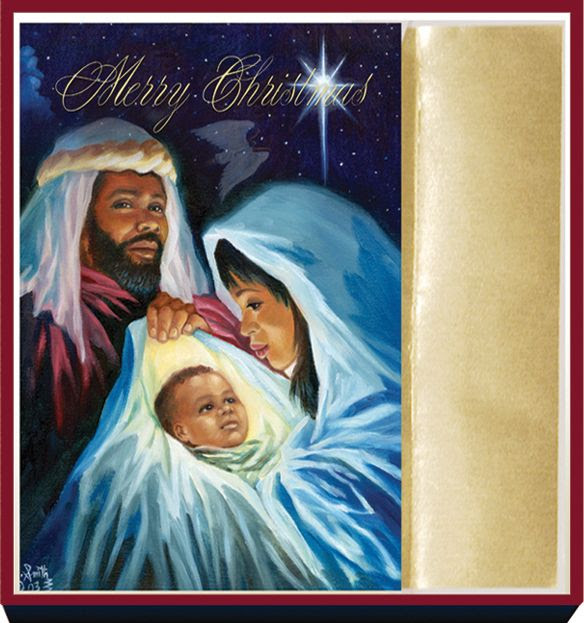An African-American Christmas
December 21, 2021
Why? Why do people think Jesus is white or god, our lord almighty is white. When in different religions he’s not. Like the black community, they believe God and Jesus look like them. But in most of the whiter populations they think Jesus and god is white., like a thousand years ago with genocide. And that assumption carried through every year. Like in the 1960s when the KKK was involved, they used Christ as a way to hurt people of color. But people of color also used christ in a way to give them strength to survive so the next generation will know the pain they overcame. So who is Jesus and God?
Christmas is to celebrate Jesus, because it’s the day he was born to his mother. And that is why Christmas is the most celebrated of all the holidays. But also like all the holidays people celebrate it differently. But Kwanzza, oh boy is the only holiday African Americans have for themselves. I celebrate Kwanzza and Christmas. I’m pretty new to the holiday, but as a black person I feel it’s my heritage to celebrate it so I do. Kwanzza always starts the day after Christmas, and it has 7 principles, each more fascinating than the last. The candles are black red and green. Black represents us, and red represents the blood and struggle of our people. And green represents the fertile land of Africa.
Unlike Christmas, Kwanzza is to celebrate the struggle and unity we built to get to freedom. To get to this new world, but now it’s like we went a thousand million years backwards. Kwanzza was founded in 1966 by Dr. Maulana Karenga, and first celebrated the same year. Which makes science considering throughout the 60s to present day black people have been the subject of bad or negative press and the subject of police brutality. Kwanzaa, was there to give black people hope in all the darkness of oppression they had to deal with and their still dealing with. Just like christmas for the christans and catholics and Hanukkah is for the jews.
The 7 principles of Kwanzaa are:
Umoja (Unity): On the first day of Kwanzaa, members of the African-American community focus on the principle of umoja. This principle emphasizes the importance of unity in all areas, including family, community, nation, and race. Celebrants light the one black candle of the Kinara, a seven-candlestick holder that is similar to the Jewish menorah.
Kujichagulia (Self-Determination): The second principle of Kwanzaa is kujichagulia, Its focus is building one’s identity as a person and a community, both historically and in the present day, by asking the question “Who am I?” Kujichagulia also encourages the question “Am I all that I ought to be?” Light the first red candle on the Kinara (a Kinara is like a menorah, but instead of 8 nights, there’s seven) on the second day.
Ujima (Collective Work and Responsibility): Ujima, the third principle of Kwanzaa, focuses on the collective responsibility for both achievements and setbacks in the community. This principle reminds celebrants that building each other up is the best way to truly solve problems. On the third day, you light the first green candle.
Ujamaa (Cooperative Economics): Light the second red candle on the fourth day of Kwanzaa, which celebrates the principle of ujamaa, or supporting each other economically. Buying from Black-owned businesses and banking with banks in the Black community keeps the economy strong in the African-American community. It also reinforces the principle from the day before – lifting up one person lifts up the whole community.
Nia (Purpose): If ujamaa emphasizes keeping money in the Black community, nia encourages Kwanzaa celebrants to focus on giving power to their spending. Nia, which means “purpose,” is the fifth principle of Kwanzaa. It can mean purpose for your own future, the financial purpose of your family, or the collective purpose of your economic community. The second green candle is lit on the fifth day of Kwanzaa.
Kuumba (Creativity): Kuumba is the principle of creativity in Kwanzaa. When celebrants light the third red candle, they focus on bringing beauty to their community through art, dance, music, and literature. The sixth day of Kwanzaa can honor prominent artists in the Black community or it can reflect the artistry of the individual. These creative works pay homage to a rich history and a vibrant future.
Imani (Faith): On January 1st, the final day of Kwanzaa, celebrants light the last green candle for the principle of imani. Imani, which means “faith,” emphasizes family and community traditions as a spiritual center. It can focus on religious faith, faith in the future of a larger community, or faith in oneself as a valuable participant in the world.
Kwanzaa is not a very talked about holiday like Christmas or Hanukkah. But I think we should recognize it more because it’s the only national holiday besides Black History month, Junteenth, Martin Luther King jr. ‘s birthday that focuses and gives hope to the black community. Not many holidays. And there are even more they we don’t even celebrate, that I didn’t know existed.
“If you have a purpose in which you can believe, there’s no end to the amount of things you can accomplish.”
——Marian Anderson




